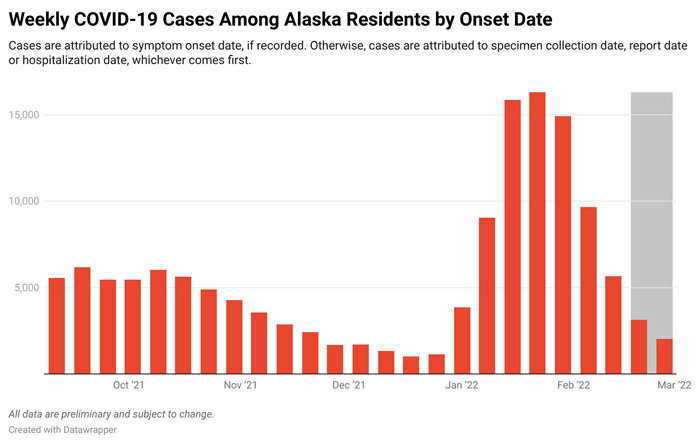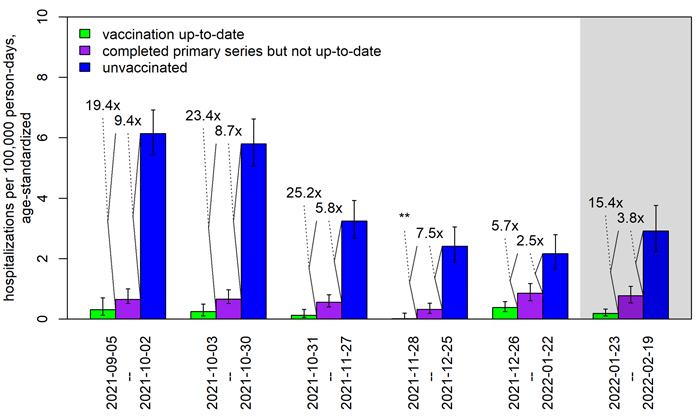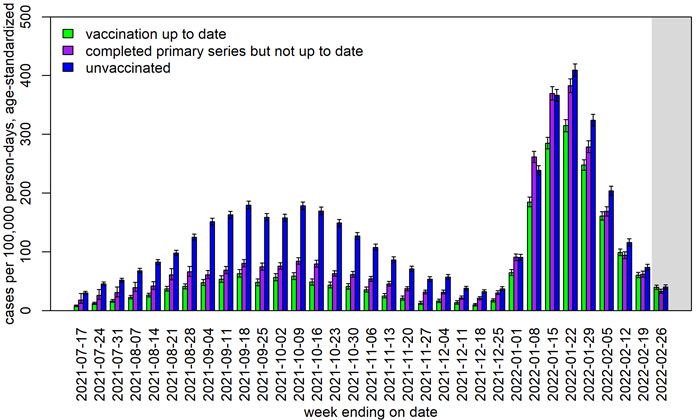
Alaska Department of Health and Social Service Weekly COVID-19 and Influenza Update
February 20 – February 26, 2022
Key Findings
- The incidence of COVID-19 remained higher than it was before the Omicron wave across most parts of Alaska during the week of February 20–February 26, 2022, though the incidence is declining in most boroughs and census areas.
- Appreciable levels of influenza transmission began occurring in mid-December but have declined over the past few weeks.
- Other respiratory viruses are circulating in addition to SARS-CoV-2 and influenza virus.
COVID-19
COVID-19 Case Trends
- COVID-19 transmission continues to occur widely throughout much of Alaska. While case counts have declined markedly since the peak of the Omicron wave, in many areas incidence remains higher than it was before the Omicron wave. Hospital admissions of persons with COVID-19 continue to decline.
- 2,292 cases were reported in Alaskans the week of February 20–February 26. This is a 31.0% decrease from the number of cases reported the week before.
- The number of reported COVID-19 cases last week was lower in all three of the largest boroughs (Municipality of Anchorage, Matanuska-Susitna, and Fairbanks North Star Borough) compared to the previous week. There was little change in the number of reported cases in the City and Borough of Juneau. The number of reported cases from the Kenai Peninsula Borough increased, but this is attributable to delayed lab reporting. Based on specimen collection dates, the number of cases from KPB last week was similar or lower than the prior week.
- The intensity of COVID-19 transmission varies between communities outside the largest boroughs. COVID-19 cases appear to be declining in many boroughs and census areas. Regardless, absolute levels of transmission remain high in many areas.
- SARS-CoV-2 genome sequencing has confirmed that the Omicron variant is the dominant SARS-CoV-2 variant in Alaska. Visit Alaska’s SARS-CoV-2 Genomics Dashboard to learn more.
- To learn more about COVID-19 cases, hospitalizations, and deaths due to COVID-19 in Alaska, visit the Cases Dashboard or the monthly report. The cases dashboard includes demographic information on cases and the monthly report includes demographic information on hospitalizations and deaths.

COVID-19 cases among Alaska residents by week of onset date.
Click here to interact with data

*Rates based on <20 observations are statistically unreliable and should be used with caution.
**Rates based on <6 observations are not reported.
COVID-19 and Hospital Capacity
- Hospital capacity remains limited. High numbers of ill patients continue to create capacity challenges across the state, with some areas more affected than others. Sick calls are improving statewide, though continue to case disruptions in select locations.
- The Crisis Care Committee remains active seeking input from, and providing guidance to, health care providers, including allocating, augmenting, or moving constrained resources during this surge to maximize the health of all Alaskans.
- As of February 28, 2022 there were 76 persons with COVID-19 in Alaska hospitals, accounting for 6.2% of all hospitalized persons. Visit the Hospital Dashboard for more data.

COVID-19 and Vaccination
- 71.0% of Alaska residents aged ≥5 years have received at least one dose of a COVID-19 vaccine. Among those who completed the primary vaccine series, 49.6% of Alaska residents ≥18 years have received their booster. Learn more about COVID-19 vaccination coverage in Alaska on the Vaccine Dashboard. Learn more about COVID-19 vaccines.
- Vaccines help protect against infection and against severe disease, especially when a person is up to date on vaccinations. During the 4-week period from January 23, 2022–February 19, 2022, unvaccinated Alaskans were 15.4 times more likely to be hospitalized due to COVID-19 than Alaskans who are up to date on COVID-19 vaccination (i.e., completed the primary series and received a booster dose, if eligible) and 3.8 times more likely to be hospitalized due to COVID-19 than Alaskans who completed the primary vaccination series but are not up to date. These estimates are lagged by one week to partially account for the time it takes to document hospitalizations. (See the monthly report for more data and analysis through December.)

Unvaccinated Alaskans are 15.4 times more likely to be hospitalized due to COVID-19 than Alaskans who are up to date on COVID-19 vaccination and 3.8 times more likely to be hospitalized due to COVID-19 than Alaskans who completed the primary vaccination series but are not up to date. In order to more easily identify changes over time, the definition of “up to date” as of January 8, 2022 was applied to data from all time points. The absolute rates of hospitalization especially in the most recent 4-week period highlighted in grey are likely underestimates because of COVID-19 hospitalizations that have not yet been documented. **Especially when rates are very low, the estimates of fold-differences between rates may be imprecise. Fold-differences are not calculated if one of the rates is based on <6 cases.
- Among Alaska residents aged ≥5 years from January 16, 2021–February 26, 2022, 66,516 cases were documented in persons who had completed the primary series and were considered fully vaccinated. Among those vaccine-breakthrough cases, 494 hospitalizations and 172 deaths due to COVID-19 have been recorded. During that time, 97,041 cases have been documented in unvaccinated Alaskans aged ≥5 years, leading to 1,818 hospitalizations and 629 deaths. All data are preliminary and subject to change.
- During the Omicron wave, the incidence of COVID-19 cases in vaccinated persons has become more similar to the incidence in unvaccinated persons. This trend likely reflects multiple factors which may include: immunity wanes over time, cases in vaccinated persons may be more likely to be detected than cases in unvaccinated persons, and there may be increased infection-induced immunity especially among unvaccinated persons.

In order to more easily identify changes over time, the definition of “up to date” as of January 8, 2022 was applied to data from all time points. Some COVID-19 cases with specimen collection in the immediate past week (indicated by the grey box) may have not yet been reported or counted.
Influenza (“Flu”)
- Reported influenza cases began increasing in Alaska in mid-December. The number of reported cases the week of February 20–February 26 slightly decreased from the number reported the previous week.
- Right now, most influenza in Alaska is caused by influenza A.
- 23% of Alaskans aged ≥10 years have been vaccinated against seasonal influenza. It is not too late to get vaccinated against influenza.
- Learn more in the weekly Alaska Influenza Snapshot.

Positive influenza lab reports in Alaska by week of specimen collection for the 2017-2018 influenza season through present. The current season through February 26, 2022 is shown in red.
Emergency Department Visits with COVID-like or Influenza-like Illness
- Syndromic surveillance consists of analyzing data on symptoms and diagnoses among patients visiting emergency departments in Alaska. The main goal is to identify trends. Unlike case-based surveillance, syndromic surveillance does not depend on laboratory testing.
- Influenza-like illness (ILI) is defined as having a fever and at least one other symptom, such cough or sore throat. Patients with a diagnosis of influenza are also included, regardless of symptoms.
- COVID-like illness (CLI) encompasses a broader array of respiratory and other symptoms than influenza-like illness. This category also includes any patient with a diagnosis of COVID-19, regardless of symptoms.
- Patients with a diagnosis of COVID-19 are excluded from the ILI category and, likewise, patients with a diagnosis of influenza are excluded from the CLI category. But a patient without a diagnosis for either could be included in both the CLI and ILI categories. CLI and ILI may be caused by respiratory viruses other than SARS-CoV-2 and influenza virus.
- As the Delta variant wave waned in Alaska in late October and November 2021, the percentage of emergency department patients with CLI declined. However, it increased in mid-December, reaching its peak in mid-January. Now, it is at a level lower than that observed in December before the Omicron wave. The percentage of emergency department patients with CLI the week of February 20–February 26 decreased from the percentage recorded the prior week.
- ILI levels increased in December but have since decreased from the late-December peak, remaining steady over the last few weeks.

New updates to protect yourself and your family
-
Masks: Masks provide both personal protection and protection to others, and they provide better protection when collectively worn. Alaskans are encouraged to consider current COVID-19 trends, personal risk factors, the new CDC COVID-19 community levels, alert levels, and other mitigation strategies in place when deciding where and when to wear a mask, and which kind to wear. Well-fitting N95/KN95 masks offer higher levels of protection than other masks.
-
Ask a health care provider about treatment: If you test positive and you’re at increased risk for severe COVID, ask a health care provider about treatment options. Treatments can reduce the risk of hospitalization and they work best when given soon after symptoms start. Learn more about COVID-19 treatments and where you can find COVID-19 treatments.
Information and Resources
- The State of Alaska COVID-19 vaccines update page
- The State of Alaska COVID-19 information page provides more information about the virus and how individuals and businesses can protect themselves and others from transmission.
- The DHSS Business and Employer Toolkits page has communications resources for any organization that wants to keep workers, partners, clients, and customers informed about COVID-19.
- DHSS COVID-19 Communication Toolkit provides PSAs, flyers, and social media graphics.
- Learn more about the importance of physical activity, highlighted by our Play Every Day and our Healthy You 2022 campaigns: Play Every Day .
- Subscribe to the DHSS Insights blog for behind-the-scenes news about Alaska’s COVID-19 response and other efforts to protect the health and well-being of Alaskans.
- DHSS offers free presentations upon request to groups about COVID-19, the vaccines, COVID-19 prevention, or other health topics upon request. Learn more or request a presentation on our Speaker’s Bureau web page.
- For the most up-to-date case information, see the Alaska Coronavirus Response Hub dashboard: data.coronavirus.alaska.gov . All dashboard data are updated Mondays, Wednesdays, and Fridays (except holidays ).
- For DHSS media inquiries, please contact clinton.bennett@alaska.gov
ECHO sessions

Session information and recordings of previous ECHO sessions
subscribe to ECHO calendar updates | email: echo@alaskachd.org | website: akecho.org
ECHO sessions create virtual learning communities by connecting Alaska's health experts with specific audiences on specific topics. These sessions are produced and facilitated by UAA’s Center for Human Development Alaska ECHO project in partnership with the State of Alaska, Department of Health & Social Services.
Below is a selection of upcoming ECHO sessions. The full schedule of ECHO sessions and access to COVID-19 ECHO videos and slideshows are available for download anytime on the DHSS ECHO web page
School Health ECHO
Monday, 3-4 p.m. (Register)
The School Health ECHO is a virtual learning network intended for professionals in the education setting (administrators, school-based nurses, etc.) to interface with a team of medical and education experts in Alaska.
Vaccine ECHO for Providers
Tuesday, 2-3 p.m. (Register)
The Vaccine ECHO for providers provides planning and operation updates to vaccine providers across Alaska, while answering any questions you may have.
Public Science ECHO
Wednesday, noon-1 p.m. (Register)
The Alaska Public Health Science ECHO is a virtual learning network intended for the general public to interface with our Public Health Leadership Team to explore the science of the COVID-19 virus, other public health topics, and current best practices. Or view via concurrent livestream to Facebook: https://www.facebook.com/akechoprograms
Healthcare Specific Situational Awareness ECHO
Thursday, noon-1 p.m. (Register)
The Healthcare Specific Situational ECHO is a virtual learning network intended for healthcare professionals to interface with our Public Health Leadership Team to explore current best practices and the most recent information related to Public Health.
|